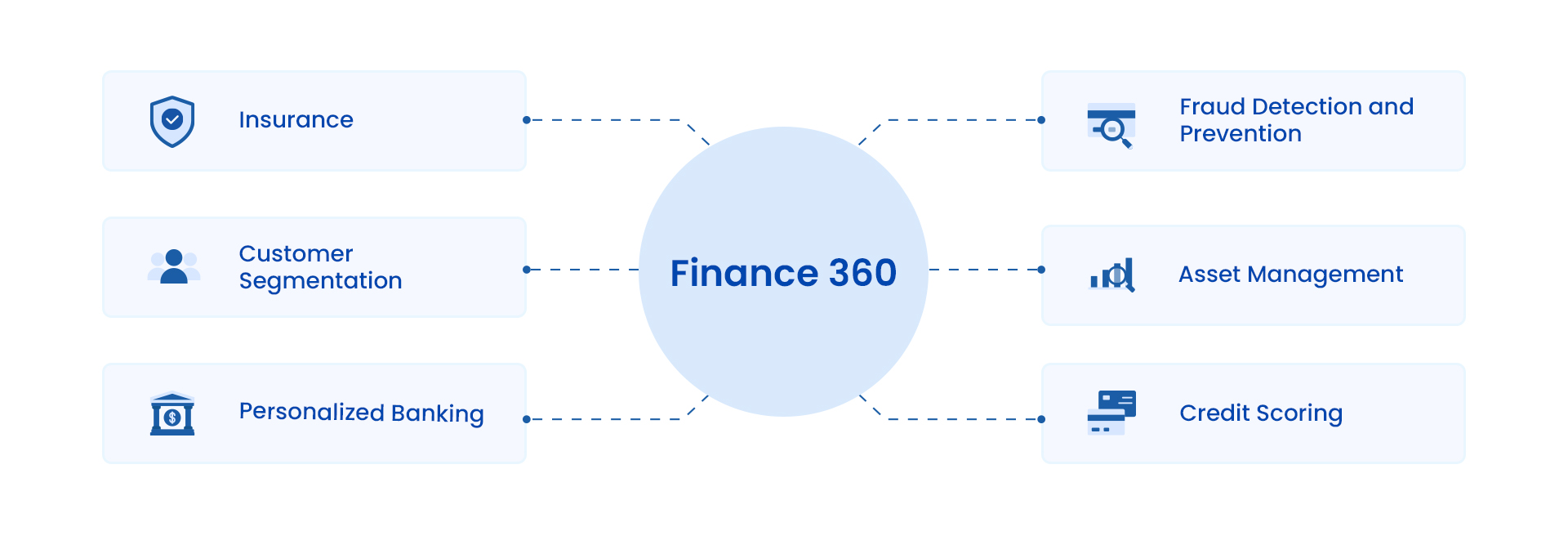
Finance 360: How ETL Drives Strategic Insights In Minutes
Did you know gaining customer behavioral insights can increase sales by 85 percent and gross margin by over 25 percent? Customer data is strategic, yet most finance organizations use only a fraction of their data. Sprawling legacy systems, siloed databases, and sporadic automation are common obstacles.
Finance 360 is a comprehensive approach to data management that bypasses these challenges, giving you a complete and accurate picture of your financial performance and health. Data pipelines enable Finance 360, allowing you to collect data from diverse sources, formats, and systems while ensuring high quality, security, and accuracy.
ETL: The Key to Finance 360
ETL is the building block of Finance 360. It facilitates the seamless collection, consolidation, and transformation of data from diverse sources and systems into a unified and standardized format. The advantages of this integration extend beyond mere organization; it significantly improves data quality and accuracy. It eradicates data silos, eliminates duplicates, rectifies errors, and addresses inconsistencies so that your businesses can cultivate a foundation of reliable and trustworthy financial data.
How No-code ETL Helps Achieve Finance 360
No-code ETL simplifies and automates the data integration process, allowing to build Finance 360 faster, easier, and more efficiently. Data pipelines help you save time and resources, improve data quality and accuracy, and enable data-driven decision-making.
As a result, the tool can help your team:
- Design, build, and execute data pipelines that perform data extraction, transformation, and loading (ETL) tasks using a graphical user interface (GUI) and drag-and-drop functionality. You don’t need to write code or script to create and run your data pipelines. You can also schedule, monitor, and manage your data pipelines from a centralized dashboard, ensuring that Finance 360 pipelines are always up-to-date and reliable.
- You can access and ingest data from any source and system, regardless of the data’s location, format, or structure. You can also convert data into a standard data model and format, such as CSV, JSON, XML, or Parquet, to facilitate data analysis and reporting. As a result, your Finance 360 solution can collect customer data from a diverse set of sources.
- Perform various data transformation and enrichment functions, such as filtering, sorting, joining, merging, splitting, aggregating, calculating, validating, cleansing, and more. You can apply various functions and operations to your data to transform and enrich it according to your business rules and logic. You can also add metadata, such as data type, data lineage, data quality, and data governance, to your data to enhance its quality and value.
Finance 360 Benefits
- Cost optimization: You can reduce your data management processes’ complexity, redundancy, and inefficiency by applying cost optimization techniques to data integration. This can lower the total cost of ownership, improve the return on investment, and free up resources for more strategic initiatives. According to a report by Gartner, cost optimization is crucial for modern data management programs, including data integration.
- Business value: You can enhance the quality, accuracy, and timeliness of your financial data by enabling greater visibility, standardization, and oversight in data management practices. This can lead to better insights, actions, and outcomes for your business. According to a study by McKinsey, by recovering and redeploying as much as 35 percent of their current data spend, companies can increase their data value by 10 to 20 percent.
- Financial perspective: You can go beyond merely listing subscribed SaaS products by providing a 360° financial perspective. You can delve into the intricate user dynamics behind these subscriptions, such as usage, adoption, and satisfaction. This can help you identify opportunities for optimizing, rationalizing, and consolidating your SaaS portfolio. According to a survey by Blissfully, a 360° financial perspective can help you save up to 30 percent on your SaaS spending.
- Pricing negotiation: You can negotiate better pricing and reduce the overall cost of your SaaS subscriptions by standardizing on a select set of tools. You can also leverage Finance 360 capabilities to benchmark your spending against industry standards and best practices and to demonstrate your value proposition to vendors and partners.
The benefits of ETL extend to enhancing both accessibility and usability. Standardizing and harmonizing financial data streamlines accessing, analyzing, and sharing information within the organization and beyond, fostering a more collaborative and informed decision-making environment.
The ultimate goal of this integration is to empower data-driven decision-making and action. Providing a comprehensive and holistic view of financial data enables businesses to uncover valuable insights, identify trends, recognize patterns, and seize opportunities that can substantially improve overall performance, efficiency, and profitability.
Use Cases for Finance 360
Insurance
Finance 360 allows institutions to comprehensively manage insurance contracts, claims, premiums, and losses by accessing and integrating data from various sources, such as reinsurers, brokers, and regulators. For instance, finance 360 can help insurance providers manage First Notice of Loss (FNOL) more efficiently.
FNOL is the initial report made to an insurance provider following a loss, accident, or theft. This process is challenging for insurers as they need to balance multiple objectives simultaneously: providing a user-friendly experience, managing real-time expectations, creating an emotional connection with customers, collecting accurate information, and keeping costs in line.
According to McKinsey, one leading North American insurer improved its FNOL process by leveraging three additional capabilities by leveraging digitization and advanced analytics.
- Digitization: The insurer improved response times by using digital technologies to access third-party data sources and connect with mobile devices. This allowed the insurer to track claimant locations, automatically dispatch emergency services, and enable customers to upload pictures of damages and file and track claims online.
- Advanced analytics: The digitization of the FNOL journey provided the insurer with more and better data faster. This allowed the insurer to apply the latest modeling capabilities to better data, improving decision making in the FNOL journey. For example, intelligent triage is used to close simple claims more quickly, and smart segmentation identifies claims likely to be total losses and those liable to require the special investigative unit (SIU) far earlier than before.
Now, let’s see how Finance 360 could help in this use case:
Finance 360 enables and empowers digitization and advanced analytics in the following ways:
- It helps the insurer measure the impact of their transformation efforts and benchmark their performance against their peers. By using Finance 360, the insurer can gain cost transparency, performance comparison, improvement tracking, and industry insights. This helps them identify areas for improvement, understand the root causes of performance gaps, track the success of improvement efforts, and learn from the best practices and strategies of top performers.
- It supports the insurer’s digitization of the FNOL journey by providing a clear view of the cost structure along the value chain. Finance 360 can help the insurer understand where they are incurring the most costs during the FNOL process and identify areas for optimization. For example, the insurer can use Finance 360 to compare the costs of different channels, such as online, mobile, or agent, and determine the optimal mix of channels for their customers.
- It enhances the insurer’s use of advanced analytics by providing access to more and better data faster. Finance 360 allows the insurer to collect and analyze data from multiple sources, such as ERP, CRM, and BI systems, and reconcile it with third-party data sources. This enables the insurer to apply the latest modeling capabilities to better data, improving decision making in the FNOL journey. For example, the insurer can use Finance 360 to segment claims based on various criteria, such as complexity, severity, or fraud risk, and assign them to the appropriate resources.
This data can help institutions streamline their operations and optimize their contracts by reducing their exposure and liability and increasing their coverage and capacity. Additionally, by using big data and analytics, institutions can efficiently estimate premiums, assess claims, and resolve disputes using historical, current, and predictive data.
Customer Segmentation
Finance 360 allows businesses to access and analyze customer data, such as demographics, transactions, behaviors, and preferences. This data can help companies to segment their customers into different groups based on their characteristics, needs, and value. For example, a business can identify its most profitable, loyal, or at-risk customers and tailor its products, services, and promotions accordingly.
This can help increase customer satisfaction, retention, and revenue and reduce costs and churn. McKinsey reports that implementing customer segmentation strategies may increase revenue by 10 to 15 percent while concurrently reducing costs by 10 to 20 percent.
Personalized Banking
Finance 360 enables banks to provide their customers with seamless and customized banking experiences by accessing and leveraging their data, such as identities, accounts, transactions, and feedback. This data can help banks deliver personalized services, such as online and mobile banking, chatbots, and voice assistants, that cater to the customers’ preferences, needs, and goals.
Furthermore, using artificial intelligence and natural language processing, banks can enhance customer interactions by understanding their queries, requests, and feedback and providing relevant recommendations and suggestions. According to Accenture’s survey, initiatives in personalized banking have the potential to elevate customer satisfaction by 20 percent and improve retention rates by 30 percent.
Fraud Detection and Prevention
Finance 360 allows institutions to consolidate and monitor transaction data from various sources, such as banks, payment processors, credit bureaus, and government agencies. This data can help institutions detect and prevent fraudulent activities, such as identity theft and money laundering, using advanced analytics and machine learning to identify patterns, anomalies, and outliers.
By detecting suspicious activities in real-time, institutions can trigger alerts and notifications and take appropriate actions to mitigate the risks and losses. IBM’s research suggests that implementing effective fraud detection and prevention measures could save the banking industry up to $4 billion annually.
Asset Management
Finance 360 allows institutions to streamline and optimize asset management processes by accessing and aggregating data from various sources, such as market trends, portfolio performance, and risk assessments. This data can help institutions manage their assets, such as stocks, bonds, and funds, using data science and optimization techniques to devise and execute effective allocation and portfolio strategies.
These strategies can help improve the assets’ performance, efficiency, and profitability and reduce costs and risks. Deloitte’s reports indicate that such methods can boost performance by 15 to 20 percent while concurrently reducing costs by 10 to 15 percent.
Credit Scoring
Finance 360 allows institutions to accurately assess their customers’ creditworthiness and risk profiles by accessing and analyzing diverse credit data, such as credit history, income, expenses, and behavior. This data can help institutions assign precise credit scores and ratings to their customers, reflecting their ability and likelihood of repaying their debts.
Moreover, by using machine learning and deep learning algorithms, institutions can refine their credit decisions by incorporating more variables, features, and models and ensuring fairness and accuracy. PwC’s analysis suggests that effective credit scoring mechanisms can reduce default rates by 25 percent and increase approval rates by 15 percent.
How Astera Enables End-to-End Data Pipelines for Finance 360
Astera is a leading ETL solution enabling end-to-end data pipelines for Finance 360. Through Astera Centerprise, businesses can establish a single source of truth for their data assets. This unified view allows for the extraction of valuable insights and facilitates informed, data-driven decision-making. By leveraging Astera Centerprise’s capabilities, businesses can effectively navigate the complexities of data integration and harness the power of their data to drive success in their finance operations.
Some of the key features and capabilities of Astera Centerprise are:
- No-code data pipeline builder and ETL solution: Astera Centerprise allows businesses to build end-to-end data pipelines without writing code, using a drag-and-drop interface and a parallel-processing engine.
- Robust, user-friendly, and scalable features: Astera Centerprise can handle complex and varied datasets, effortlessly performing ETL/ELT operations to harmonize data from transactions, customer profiles, market trends, and risk assessments. It can also load data into any destination, adding flexibility and adaptability to the process.
- Extensive library of connectors, transformations, and data quality features: Astera Centerprise offers a wide range of connectors, transformations, and data quality features, ensuring seamless integration and reliable data delivery. It can access, cleanse, transform, validate, and load data from any source to any destination, all within a unified platform.
- Single source of truth for data assets: Astera Centerprise enables businesses to establish a single source of truth for their data assets by consolidating and transforming data from various sources into a unified and consistent format. This unified view allows for the extraction of valuable insights and facilitates informed, data-driven decision-making.
Astera helps you effectively navigate the complexities of data integration and harness the power of your data to drive success in their finance operations. Astera Centerprise can also help businesses achieve significant benefits, such as:
- Reducing data integration time: Astera Centerprise’s data integration platform is designed for superior usability, productivity, and performance. It has powerful transformations, data validation capabilities, and automation features to schedule tasks, which minimize the time required to download files and set up manual integration processes, increasing productivity. As a result, your team can reduce integration time by 80%.
- Parallel Processing: Astera is backed by a parallel processing ETL engine that can execute massive integration jobs in milliseconds, making handling large volumes of data easier.
- Improving data quality and accuracy: Astera Centerprise offers comprehensive data quality features to ensure data accuracy, reliability, and completeness. It can help build an end-to-end pipeline to clean, validate, and standardize data as it arrives from different sources across the enterprise, fixing data quality issues. With the help of these features, Astera helps you improve data quality by up to 90%.
If you want to learn more about how Astera Centerprise can enable Finance 360 for your business, schedule a custom demo now!
Discover Astera's Benefits for Finance 360
Astera Data Pipeline Builder's user-friendly ETL automates data pipelines for Finance 360. Boost efficiency and create a single source of truth.
Schedule a Demo Astera AI Agent Builder - First Look Coming Soon!
Astera AI Agent Builder - First Look Coming Soon!


